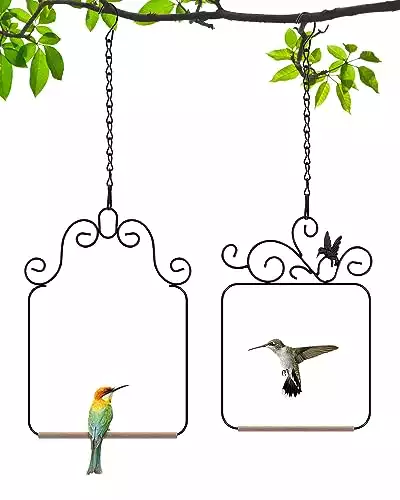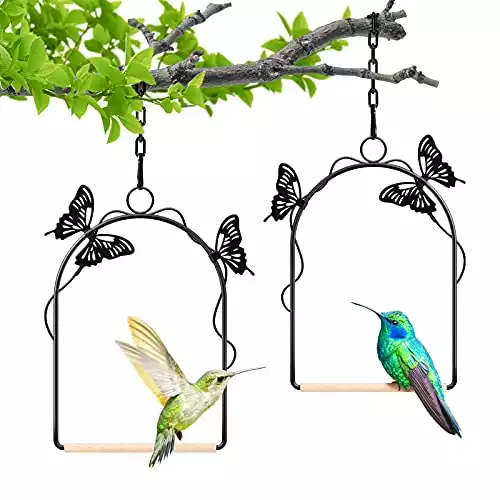Hummingbirds do perch, just not when eating. Hummingbirds will perch on a branch to relax for about 80% of their day. They also perch at night when they sleep and go into a state of torpor.
If you ever wondered whether hummingbirds perch or not, we’re here to give you the answers. If you think of most birds, you probably assume that they perch when eating, socializing, and sleeping. But hummingbirds are not like other birds, for example they only eat and drink nectar while in flight.
When sleeping, hummingbirds usually enter a state of torpor (a hibernation-like state) in which they can be found perching and on rare occasions even hanging upside down off a branch. This state usually slows down their metabolism and heart rate, but also keeps their grasps tight so they can hold on during the night.
When they eat, they tend to perch more if they have a surface near the feeder (like a swing or small bar), and when eating from tubular nectar-producing plants, they will perch on surrounding plant material that is designed for their grasp.
Curious bird-watchers worldwide, it’s time to find out if and why hummingbirds perch and how you can create the perfect spot for them to sit. Given their extraordinary flying abilities, they deserve this attention.

Table of Contents
Hummingbird Perches
Hummingbirds use perches for many different reasons, not just sitting around or taking a break. A couple of them include:
Preening
A hummingbird will begin its’ preening routine by perching on a branch or suitable surface. It will ruffle its feathers and use its bill to comb through every feather. The preening exercise helps keep the hummingbird free of dirt and parasites that would otherwise reduce the hummingbirds quality of life.
But hummingbirds do most certainly perch on their diminutive feet (which is about all those feet are good for), whether for preening, resting, or guarding a nearby feeder from rival birds – males are especially fond of doing this
Catching flying insects
Hummingbirds will perch on a branch and prey on insects that fly by. This strategy saves the hummingbird energy, and keeps their presence to a minimum; helping lure in insects and bugs that the hummingbirds can use as a nutritious protein-rich meal.
Looking out for predators
Hummingbirds are perched for about 75-80% of their day. Whether they are perched in their natural habitat or a suburban homes’ feeding station; hummingbirds will need to keep an eye out for predators. Hummingbirds also perch territorially around their food sources, including at nectar feeders provided by humans.
Chilling in the sun
Hummingbirds, like any other animal derive warmth and comfort from the sun. They can get plenty of sun, simply perching on a branch or perching surface. During cold winters, a perch could provide significant support to these little birds that are always on the look out for extra calories and any energy-conservation practices they can muster.
Advantages and disadvantages of hummingbird perches
Perches ensure that hummingbirds hang around for a longer time in your yard, not just when they visit your
The disadvantage of using a perch is that other birds will also use them (thus increasing the competition for food sources). Bird species like orioles, woodpeckers, finches, and songbirds will all be attracted to it. A way to avoid this is by putting up a smaller perch. But if your purpose is to attract a variety of backyard birds, then a perch is a considerable advantage.

Do hummingbirds need a perch at the feeder?
Hummingbirds don’t need a perch, but they could make great use of them. In their natural habitats, hummingbirds have to hover over and around their food sources in order to obtain the nourishment they need. In some circumstances, some of their food sources also have natural perching surfaces that hummingbirds use for perching.
Providing a perching bar or surface will help hummingbirds conserve energy. Hummingbirds are constantly filling up on nectar because they need to keep in flight during their travels, whether they are migrating, participating in mating rituals, or just feeding in general.
If a perch is available around the nectar feeder station, it is likely that they will hang around the feeders even more. Hummingbirds are really a treat for the eyes, so why not see them more often by providing them the extra support of a perch.
How to attract hummingbirds to your garden
The most common species of hummingbirds found in North America include the Ruby-throated Hummingbird, Anna’s hummingbird, and the Rufous hummingbird – just to name a few. You can see these tiny birds feeding on small insects and nectar that they extract from red tubular flowers, but you can always attract hummingbirds with a
Homemade hummingbird nectar is essentially sugar water. And it is exactly how it sounds: a combination of 1 part sugar to 4 parts water. Additionally, you can add a bird bath, sprinklers, and tubular plants to your garden to make it attractive to your local hummingbird population.
But there is another way to get them to like you: by offering them a place where they can perch and rest. You can build bird perches (like a cute DIY project) and place them near bird feeders, or you can order them from Amazon. You can also find wild bird feeders with an incorporated perch and moat online – the best of all worlds.
If you want to keep it easy and simple, you can use a hanger they can swing on or a birdhouse they can sit in to relax. Hummingbirds usually find places to perch in nature, but you can help by keeping your garden as wild as possible and not trimming too many tree branches.
Well, we have an even better idea for you: You can make a hummingbird swing with materials that you may already have in hand. And we’re going to show you just how easy it is.
How to make your own hummingbird swing
Any hummingbird would be happy to have a perch at their disposal – but they have some preferences too! Your perch should be ideally between 4-6 inches in length, so other big birds don’t overuse it as well. That way, you can ensure this particular perch is only for hummingbirds.
To build a hummingbird swing; make sure you have:
- A cooper wire
- Materials like wooden dowels or branches
- Nose pliers
- Wire cutters
- Scissors
- Sandpaper
- Other decorative materials – according to preference.
Instruction for building the hummingbird swing:
- Use the end of the copper wire to make a knot on one end of the perch. Don’t overdo it; just wrap the wire around a few times and make sure it’s firm.
- Curve your wire up and back down at the other end of the perch (so it should look like a door frame). While doing this, you can leave the wire straight or embellish it with all kinds of loops or (why not?) colored beads placed inside the wire. Don’t forget to leave a loop at the top part of the wire (so you can hang your swing anywhere you want). You can also create this loop at the end using another wire.
- When putting beads on the wire, you can use colors that hummingbirds love – like red, orange, or yellow. In the end, you can further decorate the swing with red bowties or knots. Get creative!
- Make sure the wire ends do not poke your hummingbirds by mistake. You can do so by sandpapering the ends.
Voila! Now watch your hummingbirds land on this beautiful swing!
Here Are Some Swings And Perches We Recommend
Final thoughts
Hummingbirds eat nectar from flowering plants, small insects (for protein), and sugar water (homemade nectar). So if you want them to love your garden and feel comfortable in it, ensure you plant enough hummingbird flowers in your garden. Focus on red tubular flowers that are just perfect for their long bills.
Feeding hummingbirds and giving them a space where they can feel at home will ensure they live longer and are more prepared for migration. Putting a perch or a birdbath near is just the next level! But since hummingbirds give us so much (by pollinating flowers) and are so gorgeous, why not make your back garden the perfect place for them to both work and relax?



